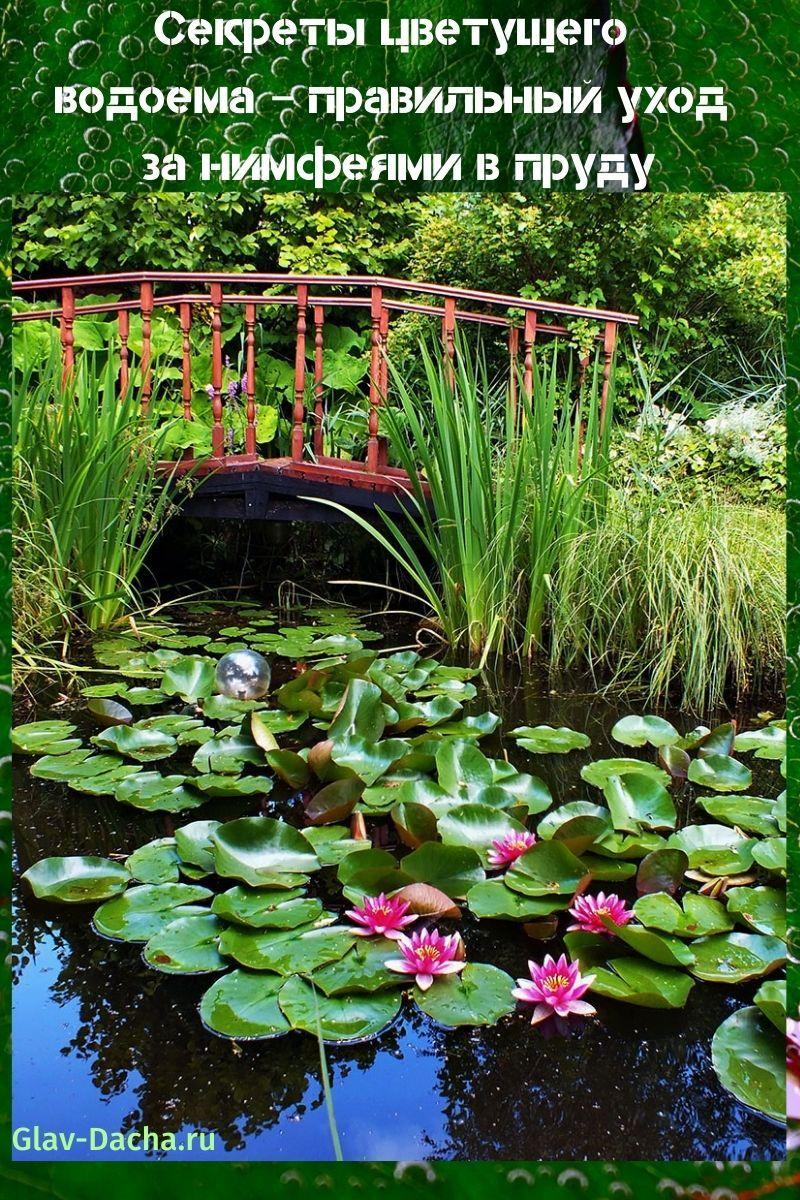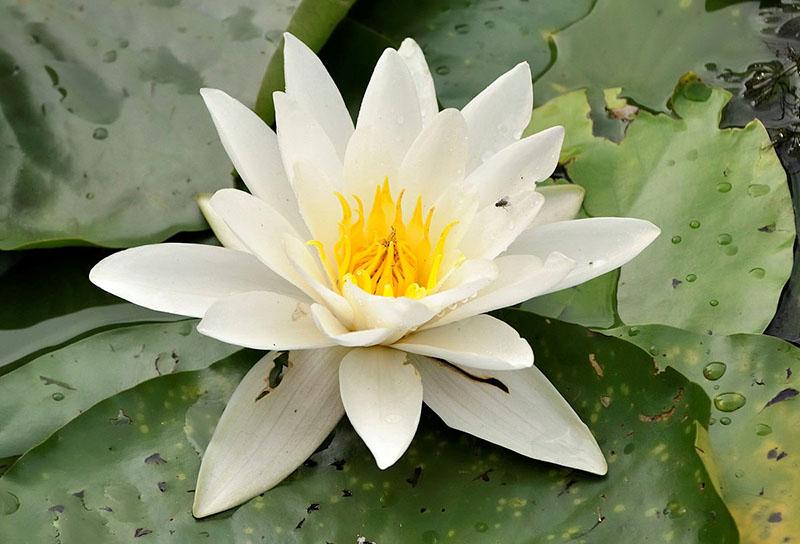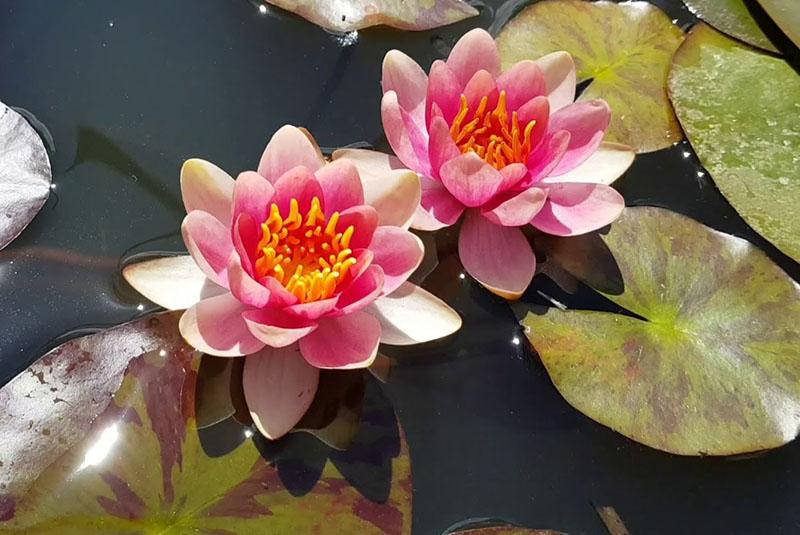Secrets of a blooming pond - proper care for nymphs in a pond
 Nymphs (water lilies, water lilies) are an unusual decoration for natural or artificial reservoirs, which is gaining popularity in landscape design. Taking care of the nymphs in the pond is simple, but you need to take into account the characteristics of the plant. If you create suitable conditions for them, they annually delight with large, symmetrical flowers of any shade.
Nymphs (water lilies, water lilies) are an unusual decoration for natural or artificial reservoirs, which is gaining popularity in landscape design. Taking care of the nymphs in the pond is simple, but you need to take into account the characteristics of the plant. If you create suitable conditions for them, they annually delight with large, symmetrical flowers of any shade.
Nymphs - description and features of the plant


Pond nymphs must meet several characteristics that are important to pay attention to when buying:
- frost resistance - some exotic varieties do not tolerate wintering, but they can be grown in containers and hidden in a warm room from low temperatures;
- the length of the roots is selected in accordance with the depth of the pond, the rhizome of the water lily can reach from 20 to 100 cm or more;
- high-quality planting material - it is recommended to choose a ready-made plant for landscaping a reservoir, since growing from seeds will be more laborious.
The period when water lilies bloom on the pond lasts from July to September. However, the lifespan of one flower is no more than 4 days.
Taking care of nymphs in the pond
 Water lilies are unpretentious plants that grow easily, quickly fill the empty space and quickly begin to bloom after planting. However, it is necessary to create suitable conditions for them, especially in artificial reservoirs.
Water lilies are unpretentious plants that grow easily, quickly fill the empty space and quickly begin to bloom after planting. However, it is necessary to create suitable conditions for them, especially in artificial reservoirs.
To follow the rules for caring for nymphs in a pond, several factors should be considered:
- purity of water - water lilies do not grow in polluted water bodies;
- enough nutrients for growth and flowering;
- suitable soil and container for planting plants;
- competent preparation for wintering, taking into account the peculiarities of the structure of the pond.
Planting and caring for a nymphaea is an easy task. In nature, these plants go deeper into the soil with the rhizome, but at home it is easier to grow them in pots. The container should be wide enough, since the roots of the water lily grow in a horizontal direction. However, do not choose too large pots so that they can be lifted and rearranged or taken to a warm room for the winter.
Pond preparation
 For a nymphea, natural or artificial reservoir with an earthen or concreted bottom - these features will determine the cultivation technology. The main care of the pond is spring cleaning. It is necessary to remove organic waste from the water: last year's fallen leaves, tree branches and other impurities. In clear water, flowers grow rapidly and fill the empty space.
For a nymphea, natural or artificial reservoir with an earthen or concreted bottom - these features will determine the cultivation technology. The main care of the pond is spring cleaning. It is necessary to remove organic waste from the water: last year's fallen leaves, tree branches and other impurities. In clear water, flowers grow rapidly and fill the empty space.
Planting water lilies
 The success of rearing and the ease of caring for nymphs in a pond depends on their correct planting. At home, plants are easier to place in containers in order to control their number and, if necessary, move in the pond. There are special containers for water lilies on sale, but any pots with drainage holes will do.Large varieties will need a capacity of at least 10–12 liters, miniature varieties need a small container. The pot may be short but wide enough for rapid rhizome growth.
The success of rearing and the ease of caring for nymphs in a pond depends on their correct planting. At home, plants are easier to place in containers in order to control their number and, if necessary, move in the pond. There are special containers for water lilies on sale, but any pots with drainage holes will do.Large varieties will need a capacity of at least 10–12 liters, miniature varieties need a small container. The pot may be short but wide enough for rapid rhizome growth.
The container is filled with a mixture in which the water lilies will grow and bloom quickly. It includes three components in equal proportions:
- high-quality wet clay, without lumps and sand;
- common land for garden and ornamental plants;
- organic fertilizer - you can use humus or manure.
A layer of mixture for growing nymphs is laid out at the bottom of the container. The plant's rhizome should be placed horizontally with the roots pointing down. The edge that is on the opposite side of the growing bud should be near the side of the pot so that the roots can grow freely. A dense layer of earthen mixture is laid out on top. It is recommended to add a layer of pebbles or small stones on the surface. They will prevent the soil from being washed out by water, and will also protect the roots from being torn apart by fish if they are in the pond.
Containers with water lilies are placed at the bottom of the reservoir. The optimal planting depth differs for different varieties, but on average is up to 60 cm. If you place the pot deeply, leaves and flowers can be on the surface, but the roots will not be warmed up by the sun's rays. Surface placement of the container will cause the leaves to float over the water too quickly. When choosing a nymph variety, it is important to take into account the size of an adult plant and its need for the depth of the water layer.
To grow water lilies, you should choose a container with two handles. With them, it is more convenient to raise the pot to the surface and move it in the pond.
Adult plant care
 Fertilizing water lilies will help them grow quickly and bloom profusely. They can be applied only once a year, during the spring cleaning of the pond, replanting plants or planting them in the reservoir after wintering. Bone meal is considered an effective food for nymphs. So that it does not wash out quickly with water and continues to act for a long time, a pinch of flour can be rolled into a clay ball and placed in a container. Also on sale there are crystalline fertilizers that deepen a little into the soil.
Fertilizing water lilies will help them grow quickly and bloom profusely. They can be applied only once a year, during the spring cleaning of the pond, replanting plants or planting them in the reservoir after wintering. Bone meal is considered an effective food for nymphs. So that it does not wash out quickly with water and continues to act for a long time, a pinch of flour can be rolled into a clay ball and placed in a container. Also on sale there are crystalline fertilizers that deepen a little into the soil.
Caring for adult plants also includes timely transplantation and control of the reproduction of water lilies.
If in the spring it is found that the rhizome is cramped in the container, it is divided into parts. It is also necessary to thin out the pond from the leaves so that they do not cover the water surface too densely. If the reservoir is less than a third full, the flowers grow as large as possible.
Reproduction of water lilies
 The easiest way to propagate a water lily is to divide the rhizome. It can be used at home to fill a large pond with flowers. The nymphea has a strong horizontal rhizome, from which small lateral roots extend. It can be divided annually and new plants can be obtained. The optimal time for flower reproduction is early spring, before planting water lilies in water bodies. However, for frost-resistant varieties that winter right in the pond, the procedure can be carried out after the last varieties have flowered - in spring it is difficult due to the low water temperature.
The easiest way to propagate a water lily is to divide the rhizome. It can be used at home to fill a large pond with flowers. The nymphea has a strong horizontal rhizome, from which small lateral roots extend. It can be divided annually and new plants can be obtained. The optimal time for flower reproduction is early spring, before planting water lilies in water bodies. However, for frost-resistant varieties that winter right in the pond, the procedure can be carried out after the last varieties have flowered - in spring it is difficult due to the low water temperature.
To propagate a water lily by dividing the rhizome, it is enough to follow a few simple steps:
- untangle the stems and raise the pot with the plant to the surface;
- with a sharp knife, separate a small section of the rhizome on which the kidney is located;
- place a piece of rhizome in a previously prepared pot with a mixture for water lilies;
- immerse the container in water and wait for the first floating leaves to appear above the water surface.
There is also a way to grow a nymph from seeds. They can be purchased at the store or assembled by yourself. In winter, they should be at a low temperature, after which it is gradually increased. In spring, the planting material is deepened into the ground and immersed in water at a shallow depth.Water lilies grow slowly, and floating leaves with flowers appear only the next year after planting. This method is rarely used at home, but it is suitable for breeding new varieties.
When nymphea breeds, it is enough to fill the pond with flowers no more than a third. The lack of space affects the size of flowers - their diameter can be reduced to 3-5 cm.
Winter care for nymphs
 There are frost-resistant and heat-loving varieties of nymphs. If the latter hibernate only in a warm room, then the method of keeping the former depends on the type and depth of the pond.
There are frost-resistant and heat-loving varieties of nymphs. If the latter hibernate only in a warm room, then the method of keeping the former depends on the type and depth of the pond.
There are several ways to care for water lilies during the cold season:
- The first option is a frost-resistant water lily variety that grows in a deep reservoir (60 cm or more) with an earthen bottom. It is the simplest one, since the pond does not freeze to the bottom even during frost. Water lilies can stay outside for the winter.
- The second option is a shallow pond with earthy soil at the bottom. For wintering, you can dig a depression and place the rhizome of the water lily from frost there.
- The third option, in which the nymphs are necessarily grown in containers and rearranged for the winter indoors, is a shallow reservoir with a concrete bottom. It is impossible for him to dig out to protect the roots from low temperatures, therefore it is necessary to prepare in advance the conditions for wintering the plant indoors.
There is a way to preserve the nymph in winter if the pond freezes during the cold season. The plant should be removed from the soil, cut off the stems with leaves. The rhizome is placed in a substrate that retains moisture well - moss or perlite will do. It can be stored in a regular plastic bag or any container in the refrigerator during the winter. The water lily tolerates the cold season well outside the pot in which it grows, provided that the substrate moisture is maintained constant.
 The water lily will become the main decoration of a large lake or a miniature home pond. There are a huge number of varieties of water lilies on sale, so it is not difficult to choose the appropriate option for a reservoir of a certain size and depth. The plant pleases with unusual flowering throughout the summer with minimal maintenance, so it is suitable even for beginners.
The water lily will become the main decoration of a large lake or a miniature home pond. There are a huge number of varieties of water lilies on sale, so it is not difficult to choose the appropriate option for a reservoir of a certain size and depth. The plant pleases with unusual flowering throughout the summer with minimal maintenance, so it is suitable even for beginners.